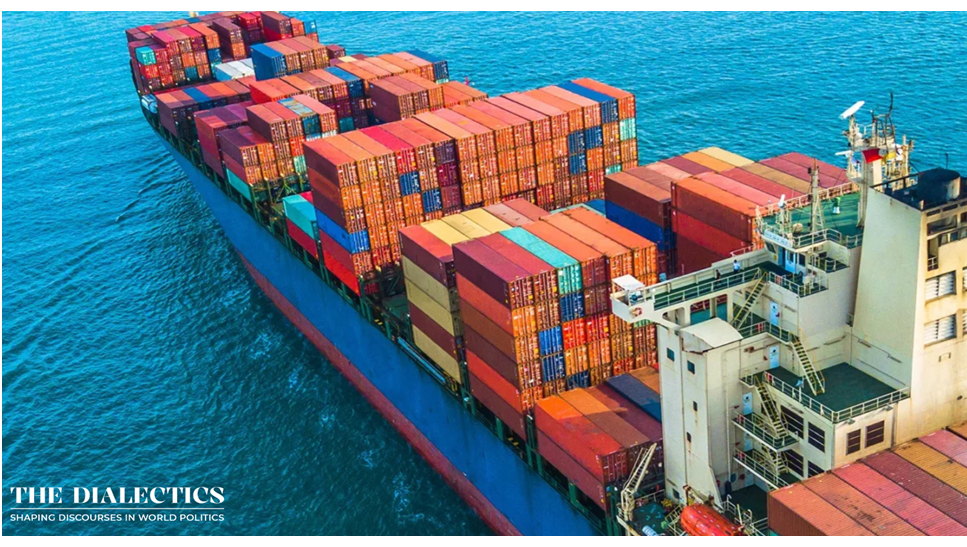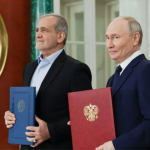India’s recent decision to revoke withdrawal of the transshipment facility it had granted to Bangladesh marks a significant shift in regional trade and diplomatic dynamics. Since 2020, this facility has enabled Bangladeshi goods—particularly ready-made garments (RMG)—to utilize Indian infrastructure for exporting to third-world countries. This decision has implications not only for India-Bangladesh bilateral ties but also for broader regional connectivity, economic interdependence, and strategic concurrence in South Asia. This paper provides a detailed examination of the decision’s background, causes, and consequences, and policy perspectives.
Background: The Transshipment Arrangement
In 2020, the transshipment facility was introduced as part of India’s larger South Asian connectivity plan. It allowed Bangladeshi exporters to ship their goods through Indian land and air routes, especially via Petrapole-Benapole border crossings and major airports in Delhi and Mumbai. Bangladesh’s RMG sector profited immensely from the initiative, which helped it overcome logistical obstacles at congested domestic ports and boosting its competitiveness internationally through reduced shipping times and costs.
For India, the initiative aligned with its “Neighbourhood First” and “Act East” policies. Under Sheikh Hasina’s leadership, it was viewed as a calculated investment in strengthening political and economic connections with Bangladesh. The facility served as a model of subregional cooperation amid global discussions on enhancing connectivity and reducing trade barriers in the Global South.
Rationale Behind India’s Withdrawal
Economic Pressures from Domestic Stakeholders
One of the primary reasons behind the rollback of the facility comes from rising concerns among Indian exporters, particularly in the textile and clothing industries. With global supply chain disruptions caused by crises like the Red Sea shipping unrest, Indian freight terminals became congested. The presence of high-volume Bangladeshi cargo put further pressure to already burdened Indian logistics systems.
Organizations like the Apparel Export Promotion Council (AEPC) raised alarms over rising air freight costs and the exclusion of Indian exporters in cargo scheduling. The Indian government, responding to these concerns and the political optics of prioritizing foreign exports over domestic ones, opted to suspend the facility in order to ease logistical difficulties.
Strategic Asymmetry and Lack of Reciprocity
Another key factor was the absence of reciprocity. While India allowed Bangladeshi goods to transit through its territory, it did not receive equivalent access for its own goods through Bangladesh to northeastern states or Nepal. Policy concerns were raised by this disparity, particularly in the absence of a formal transit treaty. Policy concerns were raised by this disparity, particularly in the absence of a formal transit treaty.
Political Realignments in Bangladesh
The change in Bangladesh’s leadership—from Sheikh Hasina to interim Chief Advisor Muhammad Yunus also played a role. Hasina’s administration had continuously aligned with Indian strategic goals, hence India had diplomatically invested in it.
However, with the interim government taking a more neutral stance and showing signs of diversifying external ties, including increased engagement with China and Turkey, Indian policymakers saw a risk in continuing strategic concessions without assured political returns.
Statements from the interim government about turning Bangladesh into a “regional transit hub”—a language reminiscent of China’s Belt and Road Initiative (BRI)—further sparked concerns in New Delhi, led to a reassessment of existing facilities.
Implications for Bangladesh
Economic Disruption in the RMG Sector
The RMG industry in Bangladesh, which employs over 4 million people and produces over 80% of the country’s exports, is currently dealing with serious logistical challenges. With transshipment via India no longer available, exporters are forced to use congested ports like Chittagong or depend on third-country hubs such as Colombo or Singapore. This might lead to delivery delays and cost increase by 15–20%, which would reduce competitiveness in time-sensitive markets like the US and EU.
Many small and medium-sized garment manufacturers, who lack the ability to quickly adapt to these developments, could suffer losses or even closures, leading to job losses and wider societal consequences.
Diplomatic Repercussions
Bangladesh views the move as abrupt and unilateral, potentially undermining trust that has built over the past decade. The Hasina government had granted India access to transit corridors, allowed energy grid connectivity, and aligned on several counterterrorism concerns. Dhaka may now view India’s choice as opportunistic and transactional.
As a result of this diplomatic friction, Bangladesh may push towards strengthening its strategic and economic ties with alternative powers like China, Russia, and members of the Organisation of Islamic Cooperation (OIC). In New Delhi, there is genuine anxiety about the possibility of Bangladesh’s strategic drifting away from India.
Regional and Strategic Consequences
Impact on South Asian Connectivity Initiatives
India’s decision to withdraw from the facility has an impact on broader regional connectivity aspirations. Frameworks like BBIN (Bangladesh-Bhutan-India-Nepal) Motor Vehicles Agreement and BIMSTEC’s trade facilitation efforts rely on mutual trust and institutionalized connectivity. The halt weakens the credibility of such arrangements and could discourage similar efforts in the future.
Although the South Asian Free Trade Area (SAFTA) under SAARC remains underutilized, bilateral and subregional agreements were seen to be the best approach towards the informal connectivity gains. Now that India has established a precedent, other nations may be deterred from taking part in non-binding transit cooperation.
Challenges to India’s Indo-Pacific Aspirations
India has positioned itself as a key actor in Indo-Pacific connectivity, especially through frameworks like the India-Middle East-Europe Economic Corridor (IMEEC). However, if India is perceived as an unreliable partner in its immediate neighborhood, its credibility as a long-term connectivity champion may suffer.
Moreover, China could seize this opportunity to enhance its influence in Bangladesh’s transport and logistics sector. As Dhaka searches for alternative routes, Chinese investment in the Payra Port and potential integration of Bangladesh into China’s Trans-Asian Railway or maritime corridors may intensify.
Legal and Normative Considerations
India’s action does not violate international law per se, since Bangladesh is not landlocked and alternative routes exist. However, the spirit of WTO’s General Agreement on Tariffs and Trade (GATT) Article V—which emphasizes freedom of transit—is arguably jeopardized.
Regional trade facilitation criteria call for predictability and minimal disruption. From a developmental perspective, the halt might disproportionately affect a lower-income neighboring country, potentially contradicting India’s global image as a supporter of South-South cooperation.
Prospects for Recalibration
Despite the setback, there is still room for recalibrating the connection through communication and institutional frameworks. India and Bangladesh are currently negotiating a Comprehensive Economic Partnership Agreement (CEPA), may provide a forum for resolving transit asymmetries and establishing the framework for reciprocal advantages in trade facilitation and logistics.
India could also consider permitting the conditional resumption of transshipment under new guidelines that prioritize Indian exporters while accommodating Bangladeshi needs. Alternatively, the two countries could institutionalize joint logistics hubs with priority quotas and cost-sharing arrangements.
Additionally, multilateral platforms like BIMSTEC could be revitalized to create region-wide transport and logistics corridors that reduce reliance on bilateral goodwill alone.
Conclusion
India’s withdrawal of the transshipment facility to Bangladesh marks a critical juncture in South Asian regionalism and bilateral diplomacy. Despite being driven by internal political and economic factors, the choice could have long-term repercussions, such as strained relations with a significant neighbor and weakened leadership in regional connectivity frameworks.
India may have gained short-term logistical relief and domestic political support, it risks ceding strategic space to external actors like China in Bangladesh. A more balanced—rooted in dialogue, legal frameworks, and regional institutions—is essential for preserving India’s regional leadership and ensuring economic prosperity in the region.




